by Dennis Dalman
editor@thenewsleaders.com
The two black-and-white photos are very, very disturbing, and they evoke pity and terror. They show the head of a 14-year-old black child named Emmett Till who was viciously beaten and shot by two white men in the summer of 1955.
The head is grotesquely swollen, distorted, bruised and lacerated. Till’s mother insisted her son’s body be shown in an open casket “for all the world to see.”
That phrase, For All the World to See: Visual Culture and the Struggle for Civil Rights, is the title of a traveling exhibit now showing at the Stearns History Museum. It includes the two brutal photos of Till’s body that were published by some newspapers and magazines in the mid-1950s, including the African-American magazine Jet. The photos in the exhibit, in fact, are in the opened pages of a Jet magazine.
News of the shocking murder – and the hideous photos of Till’s body – enraged the nation and was a direct cause of the backlash against the Jim Crow South and the struggle for civil rights that would soon get underway.
For All the World to See is an exhibition that includes the best and the worst of the black experience in America just before, during and right after the landmark Civil Rights Era of the late 1950s and 1960s.
On the bright side, the exhibit features the achievements made by great African-Americans. They include famed photographer Gordon Parks, baseball cards of pioneering black players, a front-page TIME magazine featuring “The Greatest” – Mohammed Ali (or Cassius Marcellus Clay, as he was then known), and an exhibit box showing one of the very greatest novels of the 20th Century – Invisible Man and its black American author Ralph Ellison.
There are also tributes to many black “firsts,” such as actress Diahann Carroll, the first black actress to star in her own TV series, Julia, which centered around her work as a nurse. That exhibit case features a Julia doll, a Julia lunch bucket and a Julia thermos bottle.
The exhibit also highlights the many moments of courage and determination of black people to change the systemic conditions of their oppression through demonstrations, sit-ins, legal challenges and face-to-face confrontations with blatant racists both South and North. There are exhibit cases that follow the civil-rights movement from Martin Luther King Jr. to the more radical black militants like Malcolm X and, later, the Black Panthers.
Throughout the exhibits there spring up reminders of shameful behaviors in American history: beatings, lynchings and all forms of oppression. The most shocking is the case containing the two photos of Emmett Till, which hover like an accusatory ghost above the other exhibits.
Till
Emmett Till, who was from Chicago, was spending the summer of 1955 with relatives in Money, a town in the Mississippi Delta. One day, he and some friends went to get candy at a little grocery store. Although it’s still not certain, Till was supposed to have flirted with or whistled at the white female proprietor of the store, Carolyn Bryant.
Word of that “transgression” (a blatant crime to whites at that time) reached the woman’s husband, Roy. Several days later, in the middle of the night, Bryant and his half-brother, a man named J.M. Milam, drove to the rural home where Till was staying. They rousted him from his sleep and drove him off to a barn owned my Milam where they beat him so badly his wrists and left femur were broken and an eye gouged out. The beating and torture continued for a long time before one of the men shot Till in the head. They threw his body in the Tallahatchie River after they’d tied a cotton-gin fan around his neck with barbed-wire to weight the body down.
Two boys fishing some days later found the body in the river.
Back in Chicago, tens of thousands of people walked solemnly past Till’s open casket, viewing his battered, misshapen head.
Bryant and Milam were indicted for the murder, but an all-white jury acquitted them. A year or so later, because they knew they couldn’t be tried again due to double jeopardy, the men admitted in a paid interview with Look magazine that they had abducted and killed Till.
Later, in their 60s, both men died of cancer after having lived difficult lives during which even old friends spurned them.
Shames, triumphs
At the beginning of For All the World to See there are several shameful examples of the pop-culture stereotypes of blacks in the 1950s. For example, there is a set of “Aunt Jemima” figurines, one of them a pancake syrup dispenser, along with an Aunt Jemima salt shaker next to a male “butler” pepper shaker. There is a magazine advertisement showing a black boy eating a slice of watermelon and other demeaning portrayals of black people as happy-go-lucky jolly folks who are quite content to wait on or work for white employers.
On balance, For All the World to See, despite its disturbing moments, leaves viewers with a positive impression because it clearly shows the vision, courage, suffering, pain and hard work it took to confront and to triumph over so many years of cruel racist oppression. The exhibit is also a reminder the struggle for justice and equality continues.
Museum hours
For All the World to See will be shown through May 24. The Stearns History Museum is located at 235 33rd Ave. S. in St. Cloud. Museum hours are 10 a.m.-5 p.m. Monday-Saturday and from noon-5 p.m. Sunday. Museum members are admitted free. For adults admission is $7 each. For children, it’s $3, but those under 3 are admitted free. There is a family rate of $17 for two adults and any children under 17 who accompany them.
For more information, call the museum at 320-253-8424.
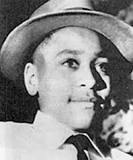
Emmett Till was only 14 when he was beaten, tortured and shot to death by two white racists in Mississippi in summer 1955.
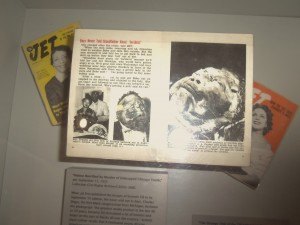
These two extremely disturbing photos show the effects of the torture and beating of 14-year-old Emmet Till in 1955 by white racists in Mississippi. Till was killed because he had allegedly whistled at a white woman. His mother insisted on having an open casket at his funeral “for all the world to see” what had been done to her son. Her words are the title of an exhibition now showing at the Stearns History Museum.
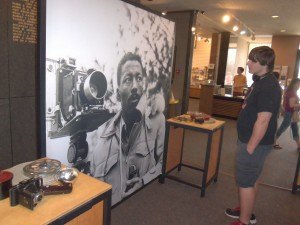
A giant photo of Gordon Parks dominates in the exhibition entitled For All the World to See at the Stearns History Museum. Parks was one of the nation’s great photographers. At right is museum visitor Austin Eastwood of St. Cloud.
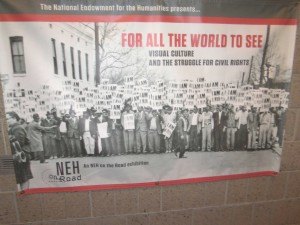
These men are all carrying placards that say “I AM A MAN” during a demonstration shortly after the assassination of Martin Luther King Jr. in 1968. The demonstrators were trying to get others to treat black people as human beings rather than aliens, animals or second-class citizens.
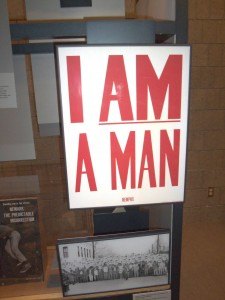
This is a lithograph placard used in demonstrations following the assassination of Martin Luther King Jr. in 1968. The point of the message was that African-Americans were trying to remind others they are human beings, not aliens, animals or second-class citizens. This is one of many displays at a new exhibit at the Stearns History Museum, entitled For All the World to See.
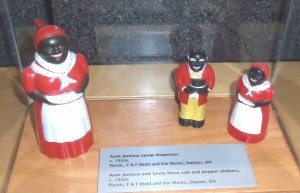
These figurines, based on the iconic “Aunt Jemima” pancake products, include a syrup dispenser (left) and salt-and-pepper shakers (right). The “male” shaker is supposed to be Aunt Jemima’s husband and resembles the demeaning “Stepin Fetchit” character so often depicted in movies before the Civil Rights Era. This is one of the many exhibits in For All the World to See, now showing at the Stearns History Museum.
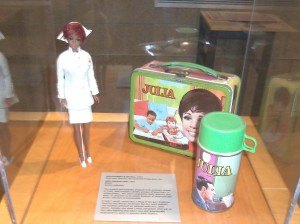
A doll, lunchbox and thermos were commercial spin-offs of Julia, the first TV show starring a black actress, which was broadcast from 1968-1971. In the series, actress Diahann Carroll played a nurse. This display can be seen in For All the World to See, a new exhibit at the Stearns History Museum.
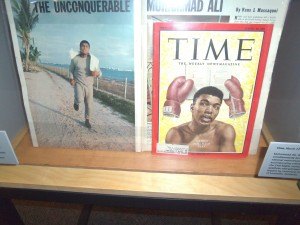
Cassius Marcellus Clay, later known as Mohammed Ali, is depicted on the March 22, 1963 cover of TIME magazine. This display is one of many in For All the World to See, an exhibit depicting black life in the United States before the Civil Rights Era.
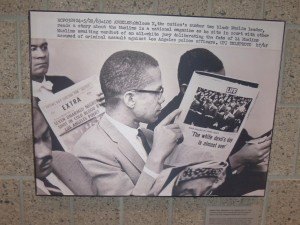
This photograph shows Malcolm X, civil-rights militant, reading an account in LIFE magazine in 1963 while sitting in a courtroom during the trial of black Muslims accused of assaulting Los Angeles police officers. The jury was all-white. Malcolm X, who was assassinated, believed blacks could not remain passive to the assaults by whites against them.
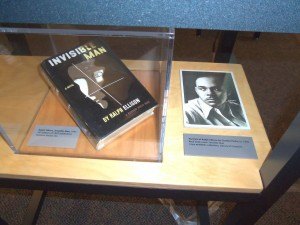
This first edition of Invisible Man by Ralph Ellison (right) is considered one of the very greatest worldwide novels of the 20th Century. It is one of the displays at an exhibition featuring black life and culture before the Civil Rights Era, now showing at the Stearns History Museum.




